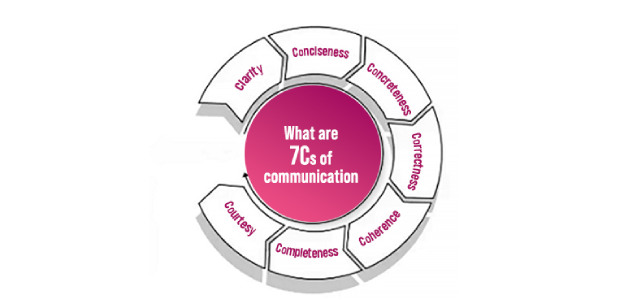
Communication is a complex process that involves the exchange of information, ideas, thoughts, and feelings . We build relationships, collaborate, and navigate the world around us through communication. Communication is effective when our messages are received and understood as intended. In this article, we will delve into the 7Cs of communication. The 10 principles of communication are also discussed to enhance our communication skills and foster stronger connections with others.
Join 100% Online Degree programs UGC Entitled and Affordable
The 7Cs of communication is a framework that provides a helpful checklist for effective communication in the entire process of human interaction. The 7 Cs of communication mentioned are very comprehensive. Effective communication is a fundamental skill that underpins success in both personal and professional life. The 7Cs of communication provide a framework for ensuring that your messages are clear, concise, concrete, correct, courteous, complete, and considerate. By adhering to these principles, you can enhance your ability to connect with others, convey your ideas effectively, and build stronger relationships.

The 7 Cs of Communication
A complete message includes all the necessary information to avoid confusion and ensure the recipient fully understands the intended meaning. Incomplete messages can lead to misunderstandings, delays, and even errors. A complete message leaves no room for doubt or interpretation. It ensures that the recipient has all the information they need to take action or make a decision.
Good Example: “Please submit your expense reports by the end of the month to the finance department. Please include copies of all receipts and a detailed breakdown of expenses.”
Bad Example: “Submit your expense reports ASAP.”
Concise messages are direct and to the point, avoiding unnecessary jargon and repetition. Brevity helps to maintain the recipient’s attention and ensures that the key message is delivered effectively. Concise messages are easier to read and understand. They also respect the recipient’s time and avoid wasting their attention on irrelevant details.
Good Example: “The meeting will be held on Tuesday at 2 PM in the conference room.”
Bad Example: “I wanted to let you know that the meeting is scheduled for Tuesday at 2 PM. It will take place in the conference room, which is located on the third floor.”
Clear messages are easy to understand and avoid ambiguity. Use simple language, avoid technical terms unless necessary, and structure your message logically. Clear messages leave no room for misinterpretation. They ensure that the recipient understands exactly what is being communicated.
Good Example: “To access the new software, please follow these steps: 1. Click on the ‘Start’ button. 2. Select ‘Programs.’ 3. Choose ‘New Software.'”
Bad Example: “Utilise the ‘Start’ button to initiate the new software application.”
Correct messages are free from errors in grammar, spelling, and punctuation. These errors can undermine credibility and distract from the message’s content. Correctness shows attention to detail and professionalism. It also helps to maintain credibility and avoid embarrassing mistakes.
Good Example: “I believe that the new marketing campaign will be successful.”
Bad Example: “I believe that the new marketing campaign will be successful.”
Coherent messages are logical and well-organised, with a clear flow of ideas. Use transitions to connect your thoughts and ensure that your message is easy to follow. Coherent messages are easier to understand and follow. They help the recipient to make sense of the information presented.
Good Example: “First, we will discuss the project’s goals. Next, we will review the timeline. Finally, we will address any questions or concerns.”
Bad Example: “We will discuss the project’s goals. There are some questions about the timeline. We will address them. Let’s talk about the project.”
Concrete messages are specific and avoid vague or abstract language. Use examples, data, and facts to support your claims and make your message more persuasive. Concrete messages are more persuasive and memorable. They provide the recipient with tangible evidence to support your claims.
Good Example: “Our sales increased by 20% last quarter due to the new marketing campaign.”
Courteous messages are polite, respectful, and considerate of the recipient’s feelings. Avoid using negative language, and show appreciation for the recipient’s time and attention. Courtesy helps to build relationships and foster goodwill. It shows respect for the recipient and creates a positive impression.
Good Example: “Thank you for your prompt response to my email. I appreciate you taking the time to review my proposal.”
Bad Example: “You need to get back to me ASAP.”
By following the 7 Cs of Communication, you can significantly improve your ability to convey your ideas clearly, concisely, and effectively. Remember that effective communication is a two-way process that requires both sending and receiving messages. By practicing these principles, you can build stronger relationships, achieve your goals, and succeed in all aspects of your life.
The core values of communication are the underlying beliefs and principles that guide our communication practices in society. They shape our approach to interacting with others and influence the way we convey and receive messages in any conversation. Some of the core values of communications are as follows:
Effective communication is a fundamental skill that enables us to connect with others through interaction, which helps in building relationships to achieve communication goals. Here are the 10 principles to guide you to make more effective communication:
Amrita AHEAD article defines effective communication as a fundamental skill that enables us to connect with others, build relationships, and achieve our goals. The article provides insights on principles of communication and the 7Cs of communication .Therefore, by understanding the core principles of communication, we can improve our ability to convey our messages clearly and effectively.
You May also Like